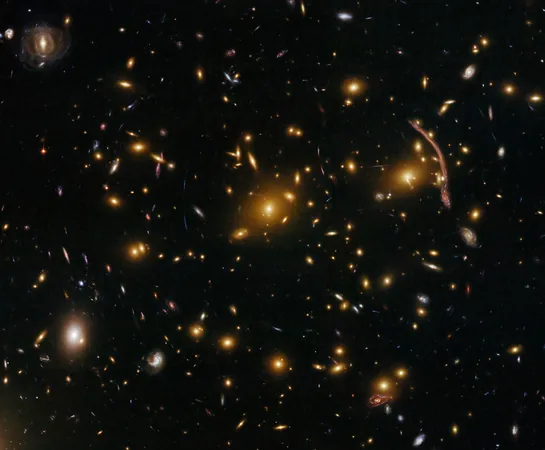
Unveiling the Cosmic Dance: How Galactic Clusters Shape Star Formation
2025-08-25
Author: Wei
A Universe of Wonders
From minuscule dust particles to massive black holes, the universe is filled with a stunning variety of celestial objects. Yet, astronomers are especially captivated by the gravitational groupings of these entities. At the smallest scale, we have planetary systems, which include planets and their moons. Then come galaxies formed by stars, black holes, gas, and dust. But, beyond mere galaxies, lie colossal structures—these galaxy clusters are formed from hundreds or even thousands of galaxies looming in the cosmos.
The Impact of Galactic Clusters on Star Formation
Scientists are on a quest to understand how these expansive structures influence the galaxies within them, especially how their formation and evolution are impacted over time. A recent study focused on the Abell 496 cluster, which boasts a staggering mass—approximately 400 trillion times that of our Sun—and is located a mere 140 megaparsecs away, equal to around 4 sextillion kilometers or 3 sextillion miles from Earth.
Evolving Galaxies: A Closer Look at Abell 496
To delve into the fate of galaxies plunging into this cluster, researchers meticulously observed 22 galaxies to see how their star formation changed as they arrived. They sought to identify when in the past billion years these galaxies ceased producing new stars, marking a significant evolutionary milestone.
Decoding the Light: Two-Piece Data Strategy
The research team employed two distinct sets of data to unveil the stars’ histories. First, they analyzed **long-wavelength emissions** from neutral hydrogen atoms in the interstellar dust—what astronomers call HI emissions. By interpreting these patterns, they gauged how much each galaxy had been disrupted by its gravitational neighbors and how much star-forming gas it retained. This data was captured using the National Radio Astronomy Observatory’s Very Large Array.
Their second approach involved examining **short-wavelength far-ultraviolet emissions** from newly formed, short-lived stars—those with 2 to 5 times the Sun's mass. By studying these emissions, they could quantify the rate at which stars form across the galaxies, using the Ultra-Violet Imaging Telescope aboard the AstroSat satellite.
Charting a Galactic Evolutionary Path
By harmonizing these two data sources, the researchers reconstructed the evolutionary journey of each galaxy, mapping out when their stars formed, how they reacted to nearby galaxies, and the longevity of their gas reserves. Understanding their position and movement within the cluster helped determine how their evolution was altered through interactions based on gravitational forces.
Stellar Formation Unraveled: The Findings
Their findings were intriguing: galaxies at the cluster's edge maintained a steady rate of star formation—deemed 'undisturbed.' Conversely, over half of the studied galaxies, located at the cluster's center, were significantly influenced by gravitational interactions. Notably, these inner galaxies had just begun their journey toward the cluster core, having only been falling in for a few hundred million years.
The Five-Step Evolutionary Sequence of Galaxies
The team devised a five-step model to describe how galaxies evolve upon entering a cluster: 1. **Pre-triggering:** The galaxies initiate standard star formation as they begin to fall into a cluster. 2. **Initial Star Formation Triggering:** Nearby galaxies disrupt their HI emissions, leading to an acceleration in star formation. 3. **Peak Star Formation:** As HI emissions become severely disturbed, star formation reaches its apex. 4. **Star Formation Fading:** Despite ongoing disruption of HI, far-ultraviolet emissions decline, indicating a drop in star production. 5. **Quenching:** Eventually, HI gas is depleted, leading to a significant drop in star formation, below pre-disturbance levels.
Recommendations for Future Research
The team's findings offer a promising reconstruction of a galaxy cluster's history. However, they advocate for future studies to ensure accurate measurement methodologies for star formation and neutral gas in distant galaxies. They also call for larger sample sizes within clusters to enhance statistical reliability and suggest exploring multiple clusters across diverse environments to gain a holistic understanding of galactic evolution.




 Brasil (PT)
Brasil (PT)
 Canada (EN)
Canada (EN)
 Chile (ES)
Chile (ES)
 Česko (CS)
Česko (CS)
 대한민국 (KO)
대한민국 (KO)
 España (ES)
España (ES)
 France (FR)
France (FR)
 Hong Kong (EN)
Hong Kong (EN)
 Italia (IT)
Italia (IT)
 日本 (JA)
日本 (JA)
 Magyarország (HU)
Magyarország (HU)
 Norge (NO)
Norge (NO)
 Polska (PL)
Polska (PL)
 Schweiz (DE)
Schweiz (DE)
 Singapore (EN)
Singapore (EN)
 Sverige (SV)
Sverige (SV)
 Suomi (FI)
Suomi (FI)
 Türkiye (TR)
Türkiye (TR)
 الإمارات العربية المتحدة (AR)
الإمارات العربية المتحدة (AR)